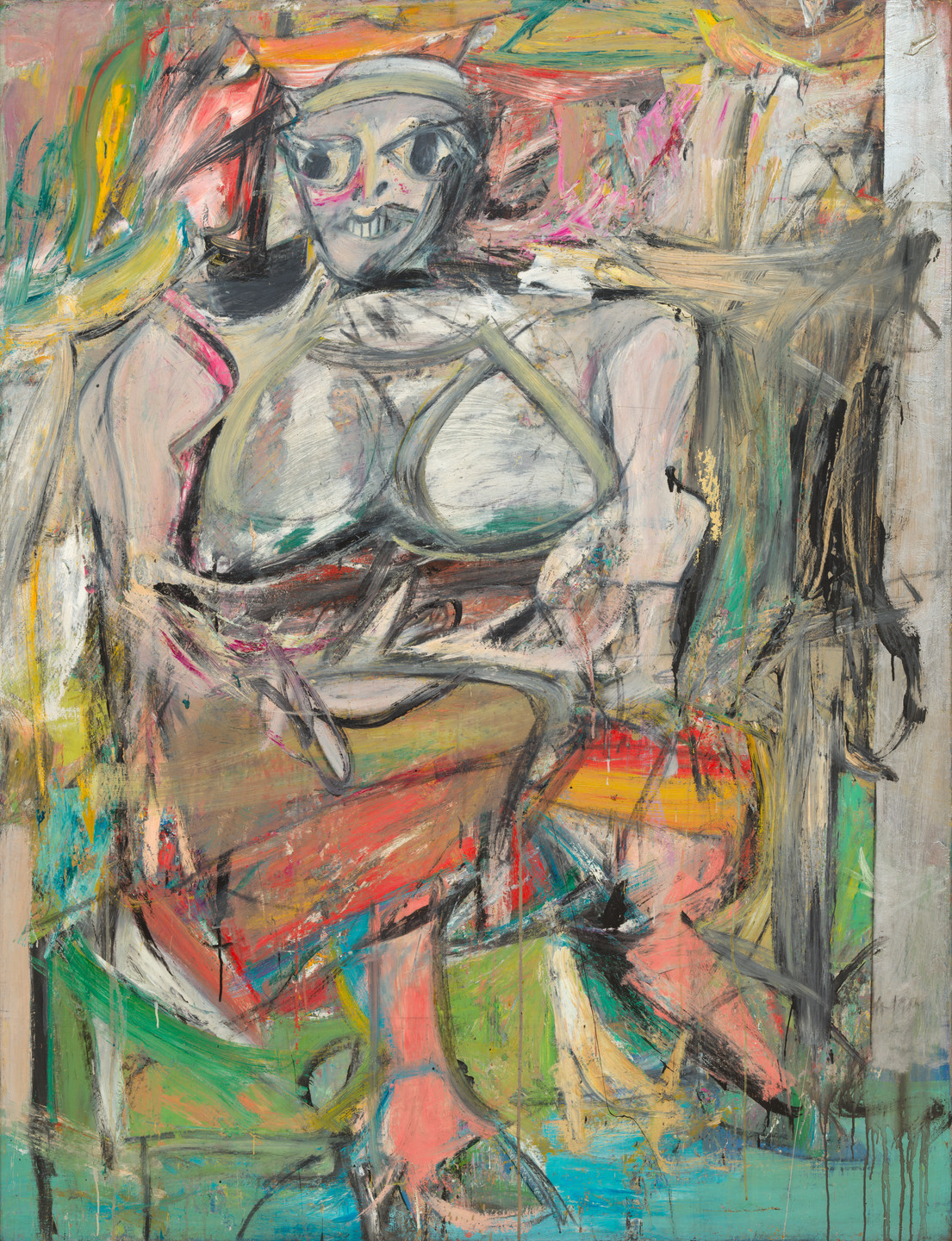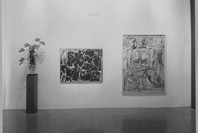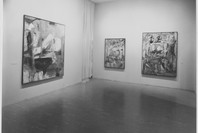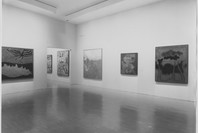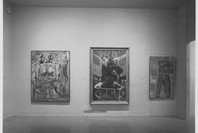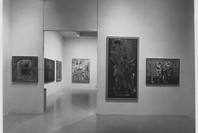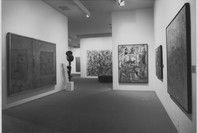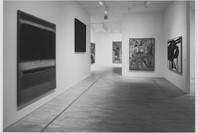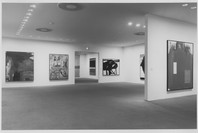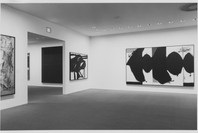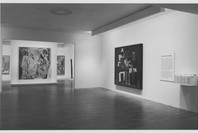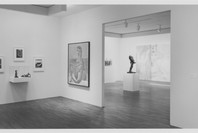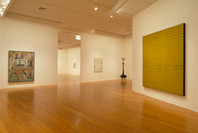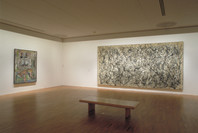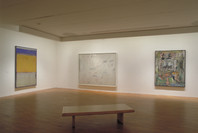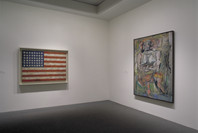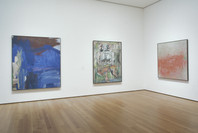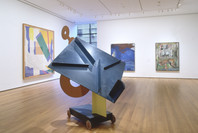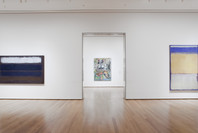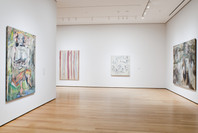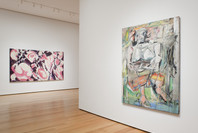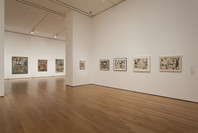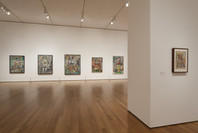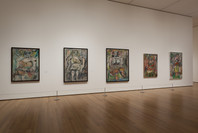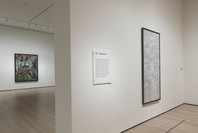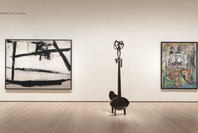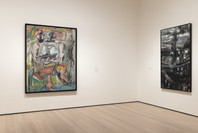“Flesh is the reason oil paint was invented,” de Kooning once remarked, and although he painted many abstractions he continually returned to the figure. Woman I took him an unusually long time to complete: he made numerous preliminary studies, then repainted the canvas repeatedly, eventually arriving at this figure of a woman, the first of a series. Some saw the painting as a betrayal, a regression to an outmoded figurative tradition. Others have called it misogynistic, understanding it as objectifying and violent. De Kooning himself said, however, “Beauty becomes petulant to me. I like the grotesque. It’s more joyous.”
Gallery label from Collection 1940s—1970s, 2019
Woman I is the first in the group of Woman paintings that de Kooning began in 1950. The works are influenced by sources ranging from Paleolithic fertility fetishes to American billboard advertisements, and the attributes of this particular figure seem to include both the vengeful power of the goddess and the hollow seductiveness of the calendar pinup. Rejecting traditional representations of women, which he summarized as “the idol, the Venus, the nude,” de Kooning painted a figure with gigantic eyes, massive breasts, and a toothy grin. Her threatening stare and ferocious smile are heightened by the artist’s aggressive brushwork and frenetic application of paint. Her body is outlined in thick and thin black lines, which continue in loops and streaks and drips, taking on a life of their own. Abrupt, angular strokes of orange, blue, yellow, and green piled up in multiple directions as layers of color were applied, scraped away, and restored. De Kooning took an unusually long time to complete this work, making numerous preliminary studies and repainting it repeatedly.
In the early 1950s, artists and critics championing abstraction had declared the human figure obsolete in painting. Instead of abandoning the figure, however, de Kooning revisited this age-old subject through the sweeping brushwork of Abstract Expressionism, the prevailing contemporary style. He famously declared, “Flesh is the reason oil paint was invented.”
Publication excerpt from MoMA Highlights: 375 Works from The Museum of Modern Art, New York (New York: The Museum of Modern Art, 2019)
Willem de Kooning: Abstraction, Representation, and Reinvention
“What you do when you paint, you take a brush full of paint, get paint on the picture, and you have fate.” So declared Willem de Kooning (American, born The Netherlands, 1904–1997), an Abstract Expressionist artist, celebrated for his exuberant paintings and vivid compositions, in which he often merged abstraction and representation. Over the course of a career that lasted nearly seven decades, he experimented continuously, shifting his style to explore new techniques and forms of expression. Such regular reinvention led to a body of paintings, drawings, prints, and sculptures characterized by boldness and innovation. As the artist once said: “Art should not have to be a certain way.”
Underlying all of de Kooning’s work, even his most abstract paintings, was a foundation in draftsmanship and commercial production. He trained in both fine and commercial art at the Rotterdam Academy in The Netherlands and worked as a sign painter, while making his early paintings and drawings in a more academic style. In 1926, the adventurous young artist stowed away on a British ship bound for the United States, skirted immigration, and moved to New York City, where the Jazz Age was in full swing. He fell under the sway of the improvisatory, lyrical freedom of jazz music and the abstract art made by other artists under its influence. New York also brought him into contact with the work of Henri Matisse and Giorgio de Chirico and with contemporaries including Stuart Davis and Arshile Gorky, with whom he developed a particularly close and mutually inspiring friendship.
The Great Depression of the 1930s brought the Jazz Age to a crashing end. As a part of President Franklin D. Roosevelt’s Works Progress Administration (WPA) program, designed to relieve rising unemployment, de Kooning was commissioned to design public murals. Though his studies for the murals were never realized, they were among his first abstractions, and his experience working on this project spurred him to pursue art making full-time.
By the 1940s, with the world embroiled in World War II and the center of creativity shifting from Paris to New York City, de Kooning had come to prominence as an artist. Although he frequently worked in an abstract style throughout the course of his career—exploring, for example, biomorphic shapes, gesture, abstracted landscapes, and pared-down forms—he continually returned to the figure. The female figure was an especially fertile subject for the artist, whose paintings of women were among his most controversial works during his lifetime and remain much discussed to this day.
A “Joyous” Grotesque: Willem de Kooning’s Woman, I (1950–52)
In 1953, The Museum of Modern Art acquired a new painting, one that prompted its collection committee to state: “The Committee found the picture quite frightening, but felt that it had intense vitality and liked the quality of the color.” The picture in question was Willem de Kooning’s Woman, I (1950–52). Though it was one of a series of six oil-on-canvas paintings centered upon a single female figure that de Kooning had worked on from 1950 to 1953, Woman, I received the most attention. The first work in this series, it seems to embody the artist’s claim: “Beauty becomes petulant to me. I like the grotesque. It’s more joyous.”
When de Kooning began to paint Woman, I, abstraction was dominant in American art. Artists and critics had declared the human figure to be an obsolete subject, and de Kooning himself was enjoying acclaim for the abstract compositions he had been producing over the previous years. Many of his peers saw Woman, I as a betrayal, a regression back to an outmoded tradition. The painting also subjected him to accusations of misogyny, as viewers perceived his portrayal of its female subject to be menacing, objectifying, and violent. For de Kooning, however, this was a continuation of his earlier explorations of the human figure and an opportunity to further experiment with the wide-ranging methods of applying paint to canvas.
The surface of Woman, I presents an almost encyclopedic display of the physical possibilities of paint, ranging from thick to thin, rough to smooth, and opaque to translucent. De Kooning prepared huge quantities of paint for this project, altering colors and textures continuously during the nearly two years he spent working on the composition. Although it may appear rapidly and intuitively executed, it is the result of many preliminary studies, numerous painting sessions, the scraping down and re-painting of entire sections, and extended consideration by the artist.
At the center of this six-feet-high by five-feet-wide painting sits the woman of its title: a figure composed of an amalgam of sweeping brushstrokes in hues of white, gray, yellow, orange, green, blue, and pink. Rough black outlines incompletely distinguish her form from the vigorous brushstrokes surrounding her. Broad-shouldered and ample-bosomed, she faces forward, with wide-open eyes taking up almost a third of her face and a virtually lipless mouth bearing long teeth. Despite such heft, she appears flattened out, pressed up against the painting’s surface.
De Kooning once summarized the history of female representations as “the idol, the Venus, the nude.” In Woman, I, he both alludes to and subverts such conventions, while possibly referencing the long-held societal ambivalence between reverence for and fear of the feminine.
